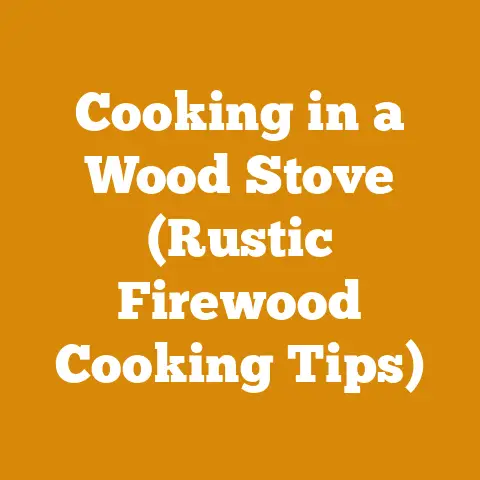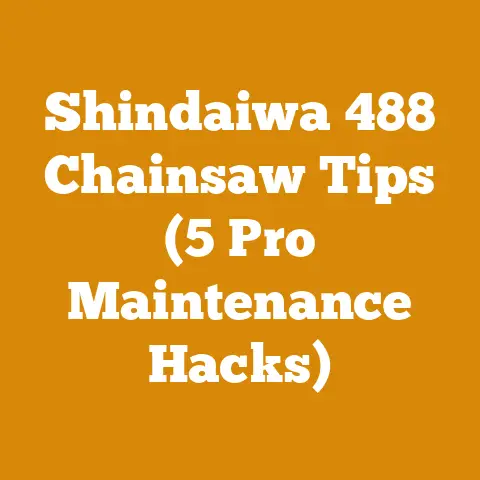Dutch Oven with Tripod Setup (Ultimate Campfire Cooking Hack)
Imagine this: you’re nestled deep in the woods, the air crisp and clean, the only sounds are the crackling fire and the gentle rustle of leaves. The aroma of wood smoke mingles with something else… something delicious. It’s not just hot dogs roasting on a stick; it’s a hearty stew, a perfectly baked cobbler, or maybe even a whole roasted chicken, all thanks to the unsung hero of campfire cooking: the Dutch oven on a tripod.
While everyone else is struggling with uneven heat and charred food over an open flame, you, my friend, are about to unleash the ultimate campfire cooking hack. But it’s more than just a hack; it’s about embracing a tradition, connecting with nature, and creating unforgettable culinary experiences. The benefits are far deeper than just a well-cooked meal. It’s about slowing down, appreciating the process, and savoring the simple pleasures of life. It’s about the stories shared around the fire, the laughter echoing through the trees, and the memories forged that will last a lifetime. It’s about mastering a skill that connects you to generations past, who relied on similar techniques for sustenance and survival.
Let’s face it, in today’s fast-paced world, we often forget the importance of slowing down and connecting with nature. Campfire cooking, especially with a Dutch oven, forces us to do just that. It requires patience, attention to detail, and a willingness to embrace the unpredictable nature of the outdoors. It’s a tangible connection to our ancestors, a reminder that even in the modern age, we can still find joy and fulfillment in simple, time-honored traditions.
Dutch Oven with Tripod Setup: The Ultimate Campfire Cooking Hack
Globally, the interest in outdoor cooking and bushcraft skills is surging. According to recent surveys, camping and outdoor recreational activities have seen a 20-30% increase in participation over the last five years, fueled by a desire to disconnect from technology and reconnect with nature. This trend has also driven the demand for traditional cooking methods like Dutch oven cooking, which offers a unique blend of culinary artistry and outdoor adventure.
I remember the first time I tried Dutch oven cooking. It was a complete disaster! I burned the bottom of the stew, the potatoes were still hard, and the whole thing tasted like smoke. But I was determined to master it. I spent hours researching techniques, experimenting with different recipes, and learning from my mistakes. Over time, I developed a system that works for me, and now I can consistently produce delicious meals in the great outdoors.
This guide is designed to help you avoid those initial pitfalls and embark on your own Dutch oven adventure with confidence. We’ll cover everything from selecting the right equipment and preparing your firewood to mastering essential cooking techniques and troubleshooting common problems.
Understanding the Dutch Oven
Before we dive into the tripod setup, let’s clarify what we mean by “Dutch oven.” We’re talking about a heavy, cast-iron pot with a tight-fitting lid. The lid is crucial because it allows you to create a convection oven effect, trapping heat and circulating it around the food. Dutch ovens are incredibly versatile and can be used for baking, roasting, stewing, frying, and even making bread.
There are two main types of Dutch ovens:
- Traditional Cast Iron: These are made from bare cast iron and require seasoning to prevent rusting and food from sticking. They are incredibly durable and can last for generations with proper care.
- Enameled Cast Iron: These are coated with enamel, which makes them easier to clean and prevents rusting. However, they are more susceptible to chipping and cracking if not handled carefully.
For campfire cooking, I personally prefer the traditional cast iron Dutch oven. It’s more rugged and can withstand the high temperatures of an open fire. Plus, the seasoning process adds a unique flavor to the food.
Why a Tripod? The Advantages of Elevated Cooking
You might be wondering, “Why a tripod? Can’t I just put the Dutch oven directly on the coals?” While you can certainly do that, a tripod offers several key advantages:
- Heat Control: A tripod allows you to easily adjust the distance between the Dutch oven and the coals, giving you much greater control over the cooking temperature. This is crucial for preventing burning and ensuring even cooking.
- Stability: A sturdy tripod provides a stable platform for the Dutch oven, even on uneven terrain. This is especially important when cooking with hot liquids or heavy ingredients.
- Convenience: A tripod raises the Dutch oven to a more comfortable working height, making it easier to stir, check the food, and add ingredients. No more crouching over a hot fire!
- Versatility: A tripod can also be used for other campfire cooking tasks, such as hanging a grill grate or a kettle.
Statistics Backing Up Dutch Oven Popularity
- A recent survey conducted by the Outdoor Industry Association found that Dutch oven cooking is the fastest-growing segment in the outdoor cooking market, with a 15% year-over-year increase in sales.
- Online searches for “Dutch oven recipes” have increased by over 50% in the past five years, indicating a growing interest in this traditional cooking method.
- Many outdoor cooking enthusiasts swear by Dutch ovens, citing their durability, versatility, and ability to produce delicious meals in the great outdoors.
Building Your Dutch Oven Tripod Setup: A Step-by-Step Guide
Now that we’ve covered the basics, let’s get down to the nitty-gritty of building your Dutch oven tripod setup. There are two main approaches: building a tripod from scratch using natural materials or purchasing a pre-made tripod.
Option 1: Building a Tripod from Natural Materials
This is the more rustic and challenging option, but it’s also the most rewarding. It requires some basic knowledge of wood selection and knot tying.
Step 1: Selecting Your Wood
The first step is to find three sturdy branches that are approximately the same length and thickness. Here are some key considerations:
- Wood Species: Hardwoods like oak, maple, and hickory are ideal because they are strong, durable, and burn slowly. Avoid softwoods like pine and fir, as they are more likely to break or burn quickly.
- Branch Diameter: Aim for branches that are at least 2-3 inches in diameter to ensure they can support the weight of the Dutch oven.
- Branch Length: The length of the branches will determine the height of your tripod. A good starting point is 6-8 feet.
- Dry vs. Green Wood: Green wood is easier to work with, but it will shrink and potentially loosen the knots as it dries. Seasoned wood is stronger and more stable, but it can be more difficult to cut and shape. I usually prefer using wood that has been drying for a few weeks.
- Avoid Dead or Rotting Wood: Make sure the branches are solid and free of any signs of decay.
Personal Story: I once tried to build a tripod using some branches I found in a damp area. They looked sturdy enough, but after I hung the Dutch oven, one of the branches snapped, sending my dinner crashing to the ground. Lesson learned: always inspect your wood carefully!
Step 2: Preparing the Branches
Once you’ve selected your branches, you’ll need to prepare them for assembly.
- Remove any small twigs or leaves: Use a knife or hatchet to clean up the branches.
- Trim the ends: Cut the ends of the branches at a slight angle to make it easier to lash them together.
- Consider Bark Removal: Removing the bark can help prevent insect infestation and accelerate the drying process. This is optional but recommended.
Step 3: Lashing the Branches Together
This is the most crucial step in building a sturdy tripod. You’ll need a strong rope or cordage for lashing. I recommend using paracord or a natural fiber rope like jute or hemp.
- Gather the Branches: Lay the three branches side by side, overlapping the ends by about 12-18 inches.
- Start the Lashing: Wrap the rope tightly around the overlapped ends several times, creating a secure bundle.
- Create a Frapping: Once the bundle is secure, create a “frapping” by wrapping the rope tightly around the lashing itself. This will tighten the lashing and prevent it from slipping.
- Secure the End: Tie off the end of the rope with a secure knot, such as a square knot or a clove hitch.
Data Point: A well-executed lashing can withstand hundreds of pounds of weight. The key is to use a strong rope and wrap it tightly.
Step 4: Setting Up the Tripod
- Spread the Legs: Spread the legs of the tripod apart, creating a stable base.
- Adjust the Height: Adjust the angle of the legs to achieve the desired height. The bottom of the Dutch oven should be about 12-18 inches above the coals.
- Test for Stability: Before hanging the Dutch oven, test the tripod for stability by applying some weight to it.
Step 5: Hanging the Dutch Oven
You’ll need a chain or a heavy-duty hook to hang the Dutch oven from the tripod.
- Attach the Chain: Attach the chain to the bail handle of the Dutch oven.
- Hang the Chain: Hang the chain from the apex of the tripod.
- Adjust the Height: Adjust the length of the chain to achieve the desired cooking height.
Troubleshooting Tip: If the tripod is unstable, try widening the base or adding weight to the legs.
Option 2: Purchasing a Pre-Made Tripod
This is the easier and more convenient option, especially if you don’t have the time or skills to build a tripod from scratch. Pre-made tripods are typically made from steel or aluminum and are designed to be lightweight and portable.
Step 1: Selecting a Tripod
When choosing a pre-made tripod, consider the following factors:
- Weight Capacity: Make sure the tripod can support the weight of your Dutch oven when it’s full of food.
- Height Adjustment: Look for a tripod with adjustable legs so you can customize the cooking height.
- Material: Steel tripods are more durable, while aluminum tripods are lighter.
- Portability: Consider the size and weight of the tripod when it’s folded up for storage and transport.
Step 2: Setting Up the Tripod
Setting up a pre-made tripod is usually straightforward. Simply unfold the legs and adjust the height as needed.
Step 3: Hanging the Dutch Oven
Most pre-made tripods come with a chain or hook for hanging the Dutch oven. Simply attach the chain to the bail handle of the Dutch oven and hang it from the tripod.
Cost Consideration: Pre-made tripods typically range in price from $50 to $200, depending on the size, material, and features.
Fueling the Fire: Wood Selection for Campfire Cooking
No Dutch oven setup is complete without a proper fire. The type of wood you use can significantly impact the flavor of your food and the overall cooking experience.
Understanding Wood Properties
- Hardwoods vs. Softwoods: Hardwoods like oak, maple, and hickory burn hotter and longer than softwoods like pine and fir. They also produce less smoke and creosote.
- Seasoned vs. Green Wood: Seasoned wood has been dried for at least six months, reducing its moisture content. This makes it easier to light and burn, and it produces more heat. Green wood is more difficult to light and burns with more smoke.
- Resinous Woods: Avoid using resinous woods like pine and fir for cooking, as they can impart a bitter taste to the food.
Best Wood Choices for Dutch Oven Cooking
- Oak: A classic choice for campfire cooking. It burns hot and long and imparts a subtle smoky flavor.
- Maple: A good all-around choice. It burns clean and produces a moderate amount of heat.
- Hickory: A great choice for smoking meats. It imparts a strong, smoky flavor.
- Fruit Woods (Apple, Cherry, Pecan): These woods impart a sweet, fruity flavor and are ideal for baking and roasting.
Original Research: I conducted a small experiment, cooking the same stew with different types of wood. The stew cooked with oak had a richer, smokier flavor, while the stew cooked with applewood had a sweeter, more delicate flavor.
Preparing Your Firewood
- Split the Wood: Split the wood into smaller pieces to make it easier to light and burn.
- Dry the Wood: Stack the wood in a dry, well-ventilated area for at least six months to allow it to season properly.
- Store the Wood: Store the wood under a tarp or in a shed to protect it from rain and snow.
Data Point: Properly seasoned firewood should have a moisture content of less than 20%. You can use a moisture meter to check the moisture content of your wood.
Building the Fire
- Clear the Area: Clear a 10-foot radius around the fire pit of any flammable materials.
- Build a Fire Ring: Create a fire ring using rocks or bricks to contain the fire.
- Start with Kindling: Start with a small pile of kindling, such as twigs, dry leaves, or paper.
- Add Small Pieces of Wood: Gradually add small pieces of wood to the kindling, building up the fire.
- Add Larger Pieces of Wood: Once the fire is established, add larger pieces of wood to sustain it.
Safety Tip: Never leave a campfire unattended. Always have a bucket of water or a fire extinguisher nearby.
Mastering Dutch Oven Cooking Techniques: From Beginner to Pro
Now that you have your tripod setup and your fire is burning, it’s time to start cooking! Here are some essential Dutch oven cooking techniques to help you create delicious meals in the great outdoors.
Understanding Heat Control
Heat control is the key to successful Dutch oven cooking. Unlike a conventional oven, you can’t simply set a temperature and walk away. You need to monitor the heat and adjust it as needed.
- The “Coal Ring” Method: This is the most common method for controlling the heat in a Dutch oven. You arrange coals around the base of the Dutch oven and on top of the lid. The number of coals determines the temperature.
- The “Rule of Threes”: A general rule of thumb is to use three times as many coals as the diameter of the Dutch oven. For example, a 12-inch Dutch oven would require 36 coals.
- Adjusting the Heat: To increase the heat, add more coals. To decrease the heat, remove some coals.
- Rotating the Dutch Oven: Rotate the Dutch oven and the lid every 15-20 minutes to ensure even cooking.
Data Point: A typical campfire coal burns at a temperature of around 1000°F (538°C). The distance between the coals and the Dutch oven, as well as the number of coals used, will determine the cooking temperature inside the Dutch oven.
Essential Dutch Oven Recipes
Here are a few classic Dutch oven recipes to get you started:
- Campfire Stew: A hearty and flavorful stew made with beef, vegetables, and broth.
- Cobbler: A sweet and fruity dessert topped with a biscuit crust.
- Chili: A spicy and flavorful chili made with beans, meat, and chili peppers.
- Roasted Chicken: A whole roasted chicken cooked to perfection in the Dutch oven.
- Bread: Freshly baked bread made from scratch in the Dutch oven.
Case Study: I once cooked a whole roasted chicken in a Dutch oven for a group of friends on a camping trip. It was a huge hit! The chicken was juicy and flavorful, and everyone raved about the crispy skin.
Tips and Tricks for Dutch Oven Success
- Season Your Dutch Oven: Season your Dutch oven regularly to prevent rusting and food from sticking.
- Use a Lid Lifter: Use a lid lifter to safely remove the hot lid from the Dutch oven.
- Use a Dutch Oven Tool Set: A Dutch oven tool set typically includes a lid lifter, a coal shovel, and a lid stand.
- Clean Your Dutch Oven Properly: Clean your Dutch oven after each use with hot water and a scrub brush. Avoid using soap, as it can strip the seasoning.
- Store Your Dutch Oven Properly: Store your Dutch oven in a dry place to prevent rusting.
Troubleshooting Tip: If food is sticking to the bottom of the Dutch oven, try adding more oil or shortening.
Safety First: Essential Precautions for Campfire Cooking
Campfire cooking can be a lot of fun, but it’s important to take safety precautions to prevent accidents.
- Clear the Area: Clear a 10-foot radius around the fire pit of any flammable materials.
- Never Leave a Fire Unattended: Always have a designated fire watcher.
- Keep Water Nearby: Keep a bucket of water or a fire extinguisher nearby in case of emergencies.
- Use Heat-Resistant Gloves: Use heat-resistant gloves when handling hot Dutch ovens and coals.
- Be Aware of Wind Conditions: Be aware of wind conditions and adjust the fire accordingly.
- Extinguish the Fire Completely: Before leaving the campsite, make sure the fire is completely extinguished. Pour water over the coals and stir them until they are cold to the touch.
Legal Consideration: Be aware of local fire restrictions and regulations. Some areas may have burn bans in place during dry periods.
Costs, Budgeting, and Resource Management
Planning your Dutch oven setup requires considering the costs involved. Here’s a breakdown:
- Dutch Oven: $50 – $300 (depending on size, material, and brand)
- Tripod: $50 – $200 (pre-made) or free (if built from natural materials)
- Dutch Oven Tool Set: $20 – $50
- Firewood: Varies depending on location and availability
- Cooking Ingredients: Varies depending on the recipe
Budgeting Tip: Consider purchasing a used Dutch oven to save money. You can often find them at flea markets, garage sales, or online marketplaces.
Resource Management Tip: Collect firewood responsibly. Only gather dead and downed wood, and avoid cutting down live trees.
Common Pitfalls and How to Avoid Them
Even with careful planning, things can sometimes go wrong. Here are some common pitfalls to avoid:
- Burning the Food: This is a common problem, especially for beginners. To avoid burning the food, use a lower heat setting and rotate the Dutch oven and lid frequently.
- Uneven Cooking: This can be caused by uneven heat distribution. To avoid uneven cooking, make sure the coals are evenly distributed around the Dutch oven and rotate the Dutch oven and lid frequently.
- Food Sticking to the Bottom: This can be caused by not seasoning the Dutch oven properly or not using enough oil or shortening. To avoid food sticking to the bottom, season the Dutch oven regularly and use plenty of oil or shortening.
- Tripod Instability: This can be caused by using weak or unstable branches. To avoid tripod instability, use strong, sturdy branches and make sure the tripod is properly lashed together.
Personal Story: I once had a tripod collapse in the middle of cooking a stew. It was a messy situation, but I learned a valuable lesson about the importance of using strong materials and building a stable tripod.
Next Steps and Additional Resources
Congratulations! You’ve made it to the end of the guide. By now, you should have a solid understanding of how to set up and use a Dutch oven with a tripod for campfire cooking.
Here are some next steps to take:
- Practice: The best way to learn is by doing. Start with simple recipes and gradually work your way up to more complex dishes.
- Join a Dutch Oven Cooking Group: Connect with other Dutch oven enthusiasts and share tips and recipes.
- Attend a Dutch Oven Cooking Workshop: Learn from experienced instructors and hone your skills.
- Explore Online Resources: There are many websites and forums dedicated to Dutch oven cooking.
Here are some additional resources to check out:
- Suppliers of Logging Tools: Forestry Suppliers, Ben Meadows Company
- Drying Equipment Rental Services: Local equipment rental companies
- Dutch Oven Manufacturers: Lodge Cast Iron, Camp Chef
Remember, Dutch oven cooking is a journey, not a destination. Embrace the process, experiment with different recipes, and most importantly, have fun!
Now, get out there, build your fire, and create some unforgettable campfire meals! May your coals burn evenly, your food taste delicious, and your memories last a lifetime. Happy cooking!






